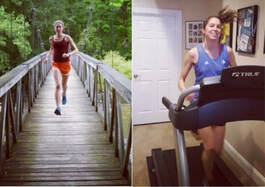 It may have reached 60 degrees in Boston yesterday, but with January and February approaching, there's guaranteed to be some icy and snowy days in most of the US. The most common question I get this time of year is- "Is running on the treadmill the same as running outside and is it okay if I do some of my runs on the treadmill?" Keep reading to find out about the physiological differences between treadmill running and outdoor running, some tips on how to use the treadmill properly, and some advice on how to avoid it (if you want to!). Is there a physiological difference between running on the treadmill and running outside?Even though these are both forms of the same activity, there actually are some physiological differences! When the treadmill's belt moves below you, it pulls the foot that is in contact with the ground behind you. When striding, this puts more strain on the quads and takes some strain away from the hamstrings in comparison to an outdoor stride. Therefore, quad-dominant runners may find treadmill running easier than hamstring-dominant runners. (Side note: Treadmill running may help one recover from a hamstring injury because it takes some of the stress off that muscle.) Does this physiological difference affect training? It isn't obvious, but keep in mind that races are run outdoors. If you are solely running on the treadmill, you may want to consider getting outside sometimes. If weather conditions are not ideal, should I run on the treadmill to ensure that I hit my goal workout paces?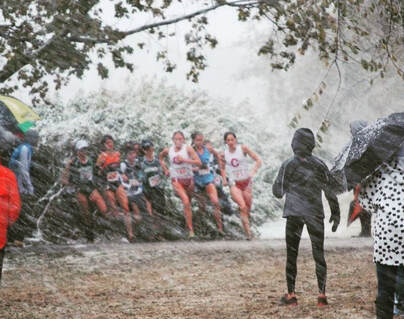 Me and Cornell teammate, Genna Hartung, racing in surprise snowy conditions at the Ivy League XC Championships in Oct 2011 Me and Cornell teammate, Genna Hartung, racing in surprise snowy conditions at the Ivy League XC Championships in Oct 2011 Running in poor weather makes you more prepared for poor weather racing conditions (think Des Linden winning the 2018 Boston Marathon). There is a lot to gain from pushing through a workout in the windy rain, even if it means that the splits are slower than what they would have been on a clear day. When I lived in Michigan, my coaches had a us do an experiment where we ran a tempo on a snowy day in Michigan and then hopped on a plane and did the same tempo in ideal temps in Florida. After shedding layers and getting out of the wind, I was 30 seconds per mile faster in Florida. Yes, the paces were slower in the tough conditions, but I was still getting the necessary fitness in. For long road races, running in harsh conditions often translates to fast times in ideal conditions, but the opposite is not always true. Therefore, I like to look at the challenging weather days as opportunities to make me stronger, rather than getting frustrated. The exception to this rule is dangerous conditions. If you feel unsafe, you should stick to the treadmill. My best advice? Mix it up. For speed workouts where you want to prioritize fast turnover, hit the treadmill. For tempos, practice running in tough conditions and worry less about exact splits. How can I run in slippery and snowy conditions if I don't have access to a treadmill?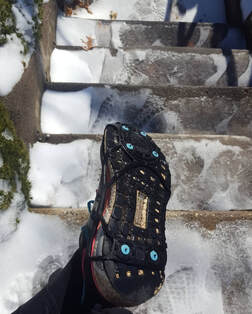 Due North running cleats Due North running cleats Traction spikes make a huge difference when running on the snow. I was skeptical at first. I thought the spikes would feel heavy, clank on the ground where there wasn't snow, or simply fall off. I was having difficulty keeping up with my running friends who were wearing them, so I eventually gave in and it was a game changer. Personally, my favorite brand is Due North. The cleats come in a few different sizes and the spikes are small, so I am also able to run where there is no snow on the ground with limited irritability. They are great if you want to go out for a run and enjoy the snow without getting frustrated! How do you properly run on the treadmill?Many runners are subconsciously nervous about falling off the back of the treadmill. Therefore, they run close to the front of the belt. While this may seem safer, it will cause the runner to shorten their stride. Such alterations in running form could lead to injury or make running on the treadmill unnecessarily difficult. Aim to let yourself run in the middle of the treadmill, which may feel like the back. In addition, when logging miles on the treadmill, you may want to consider setting the incline to 0.5% to account for the air resistance that you would encounter running outside. My GPS watch and the treadmill display do not match. Which should I trust?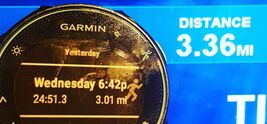 Unfortunately, GPS watches, even on their indoor mode, aren't very accurate on the treadmill. I always go by the treadmill display for both the pace and distance. While is possible that a treadmill may not be calibrated correctly, I find the watch is usually less accurate. Remember, don't be too much of a perfectionist with pace when running on the treadmill. As long as you feel like you got in the proper effort, then you accomplished the goal of the day. An interesting treadmill study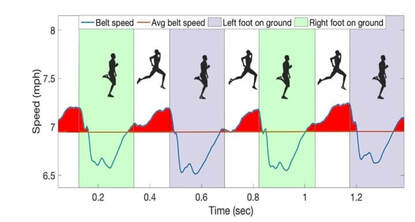 According to a study done by @strydrunning (using their foot pod power sensor), the treadmill's belt speed is not constant. "When your foot strikes the belt, the motor is loaded in the belt slows temporarily. Conversely, when your body is in the air, the motor applies an extra speed to the belt to recover from the previous loading." What does this mean for you as a runner? If your treadmill is properly calibrated, about 2% of the distance the belt travels during your run is "free distance" that is recorded by the treadmill but does not have any metabolic cost to you. The figure above, taken from the Stryd Blog article, displays belt speed over the time of a runner's stride. Does this mean running on the treadmill is easier than running outside? Possibly, but it depends on how your treadmill is calibrated and whether you run with a normal stride when you are on it.
1 Comment
|
Archives
November 2020
Categories |

 RSS Feed
RSS Feed